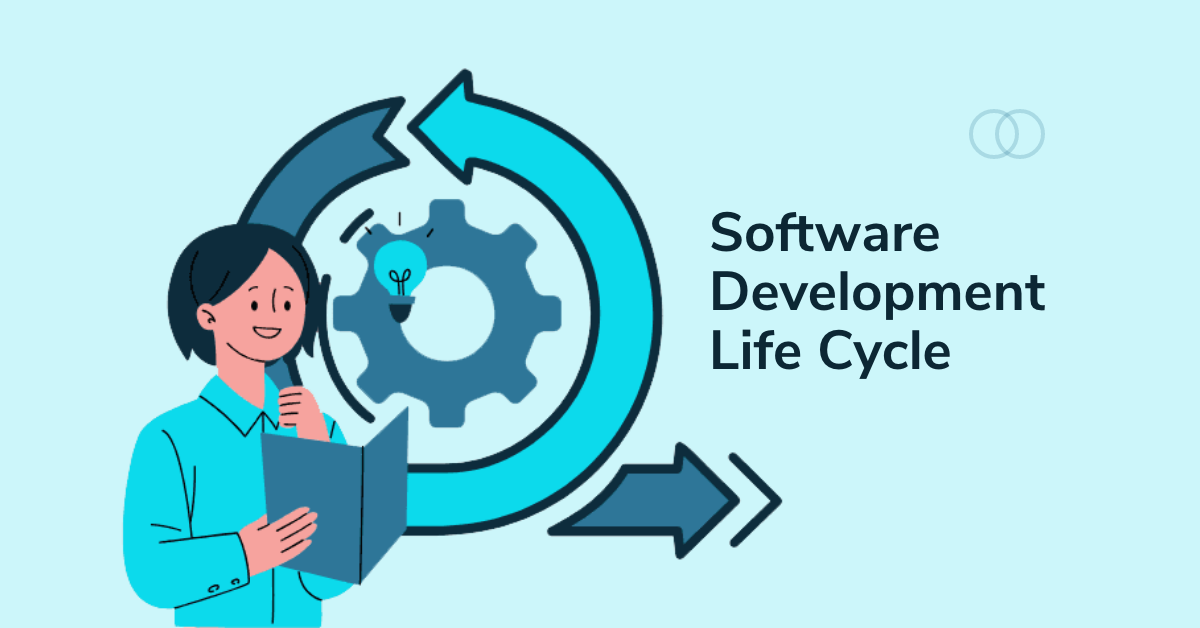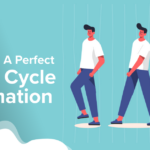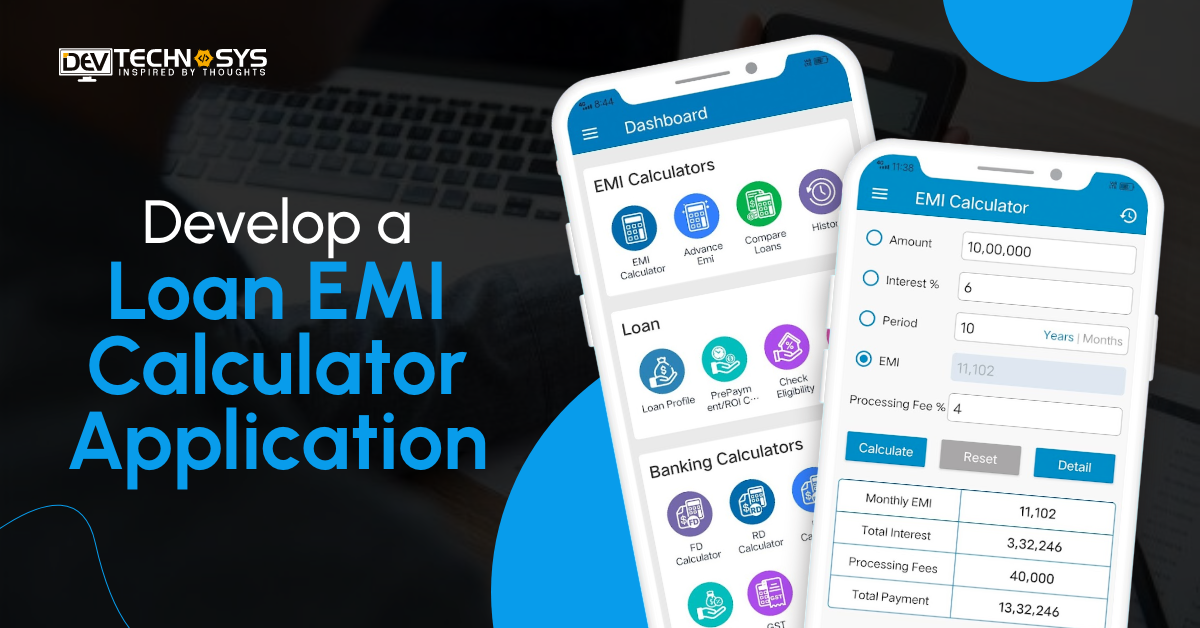“If you fail to plan, you’re planning to fail.”
– Benjamin Franklin.
Have you ever hit a wall when trying to develop a mobile application? If that’s the case, you really should be familiar with the software development life cycle by now.
The success of software relies on a clearly defined software development life cycle. As per statitsa, the market for software is predicted to increase at a CAGR of 11.5% from 2023 to 2030, with a valuation of $583.47 billion in 2022. The picture below depicts the demand for software markets all over the world.
Therefore, it is the perfect time to build software if that is your ultimate objective. I know what the real process of making software is because our project managers made many software solutions and use top-notch software development life cycle methodologies.
In this guide for modern software development life cycle, We’ll look at the steps in the SDLC and the different models that software can be managed.
So, let’s begin!!
Table of Contents
What Is Software Development Life Cycle?
The software development life cycle is a set of methods used by software developers to plan, build, and test software of the top-notch quality. They use multiple methodologies like Agile, Waterfall, V-model, Spiral to design and develop software.
The developers must build, test, release, and maintain their software to ensure it works perfectly, on time and budget. During the development stage, the Life cycle of software development helps figure out the future issues and risks.
So, software product development companies can come up with answers to problems before they happen. This cuts down on unnecessary lags in the software development process and boosts output.
Market Statistics & Scenarios Of Software Development
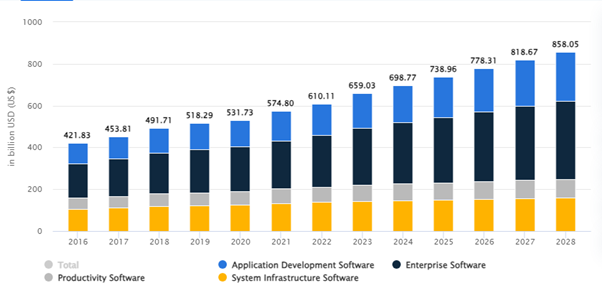
Source: Statista
- Nearly 47% of those surveyed in 2022 said they developed software utilizing a DevOps or DevSecOps approach.
- The market for software lifecycle development is predicted to increase at a CAGR of 11.5% from 2023 to 2030, with a valuation of $583.47 billion in 2022.
- In 2024, the software market is forecasted to generate $698.80 billion in profit.
- The market is dominated by enterprise software, which is expected to generate $292 billion in revenue by 2024.
- A CAGR of 5.27% is predicted for sales between 2024 – 2028, translating into a market reach of $858.10 billion.
- When compared globally, the USA will produce the most revenue ($353.50 billion in 2024).
At Dev Technosys, where I’ve worked for over 5 years as a project manager, my main focus has always been on providing that clients receive effective project outputs. I can prioritize features, lower risks, and make sure projects meet client goals because I know a lot about SDLC. Through my own experiences, I have learned that an excellent Agile software development life cycle could greatly enhance project outcomes.—Navneet Singh Rajput (Project Manager)
6 Stages Of Software Development Life Cycle
Software Development Life Cycle processes are meant to be more efficient by setting clear goals, and steps for each part. The software startup solutions include planning, requirement gatherings, development and other stages. Let’s look at the stages of each of the software development life cycle phases:
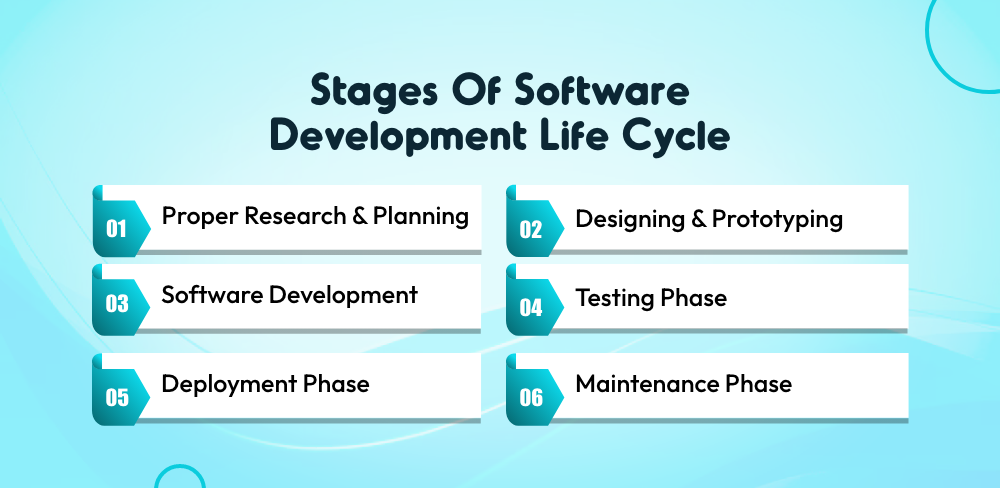
1. Proper Research & Planning
The software team analyzes target features, functions, and goals with those involved throughout needs obtaining and analysis. The IT consulting services team looks at the current systems and processes and sets goals for the project.
Any mistakes in this step could lead to expensive mistakes and extra work during development. It is important to know and write down requirements to make software that meets the needs of users. The demand of the business while remaining in the budget, time, and scope limits.
2. Designing & Prototyping
During this part of the SDLC, the software structure and layout are also made. When designers make UI aspects, they think about the UX, they want to create and make sure that the parts are easy to use, make sense, and look good.
Here, prototyping can be required. During this step, the QA team also makes a testing plan that spells out what they’ll test and how they’ll test it. This stage tells the enterprise product development team what to do, makes it clear how the software is structured and how it works, and helps the team handle risks and resources well.
3. Software Development
At this stage, writing, testing, and fixing bugs in the software code is called “development.” When the software is being made, agile methods are most useful. Teams use Agile to be more flexible, work together better, and make it possible to create software things in small steps.
Agile methods additionally facilitate regular contact between the business and the software development company. It is important for openness and lets everyone give feedback and make changes quickly.
During the development stage, it is crucial for stakeholders, notably QA teams, to work closely together to make sure that the software is developed correctly, works reliably, and is defect-free.
4. Testing Phase
It sounds just like what it is: the testing and QA stage. The software testing services provider plans and runs tests on the software to assure it operates well, is safe, and is reliable.
Various types of testing are used at this stage. Any problems or bugs found by these tests are fixed, and then delivered to the developing team to be fixed. As part of QA, the software is also checked against the norms to be sure it works the way it’s supposed to.
Thorough testing helps find and fix bugs prior on in the development process. This lowers the chance of expensive problems after the software is released and makes sure that it meets users’ needs and expectations.
5. Deployment Phase
After QA gives the software the all-clear, it needs to be made ready for users. During the deployment and execution stage, this process takes place. Along with setting up the software setup, moving data, and configuring the system, the development team assists the client.
They also give users any instruction and data they need. This step is needed to make sure that the software goes into production without any problems and to teach people how to use it. The team must be aware of the software development trends for better functionality.
It will also keep an eye on how the software works and fix any problems that come up after the launch to keep the system stable and effective.
6. Maintenance Phase
The last step of the SDLC includes all the tasks that need to be done to fix problems that real users report and make any changes that are needed to the software after it has been released.
Adding changes to fix bugs that weren’t fixed before launch is an example of the second type. Large, complicated systems may need more upkeep steps than smaller ones.
At this point, the custom software development company releases periodic upgrades, bug fixes, and safety fixes to maintain the software safe and working well. In this part, you’ll also be giving end users technical support and answering their questions or concerns.
It’s vital not to forget how essential the maintenance and support step is. Fixing any problems, making the system run better, and planning for future improvements are all important for the user experience and customer happiness.
7 Popular Software Development Methodologies
There are so many software development methodologies out there that dedicated software developers can’t decide which one to use. The waterfall, iterative, and continuous models can be used to describe the majority of models.
1. Waterfall Model
The Waterfall model is the oldest software development model. The software development life cycle sdlc starts and proceeds through each step in a straight line, just like a waterfall. However, the next step can’t begin until the last one is finished. Waterfall model helps a POS software development company work out if every stage of the process can be done constantly and if it is even possible. This can help get rid of any problems that cause delays or separate work.

Suitability: This model works best when rules and standards don’t change much and results are known ahead of time.
| Pros Of Waterfall Model | Cons of Waterfall Model |
| Uses clear structure | Make changes complex |
| Requirements are fixed | Delay in testing |
2. Prototype Model
In the prototype methodology, the software development team makes a simple version of the software. It helps users to test its usefulness and make sure the user flow works. When users test the prototype, PM gets input and makes changes to the next versions of the software until the ideal version of the working model is reached.
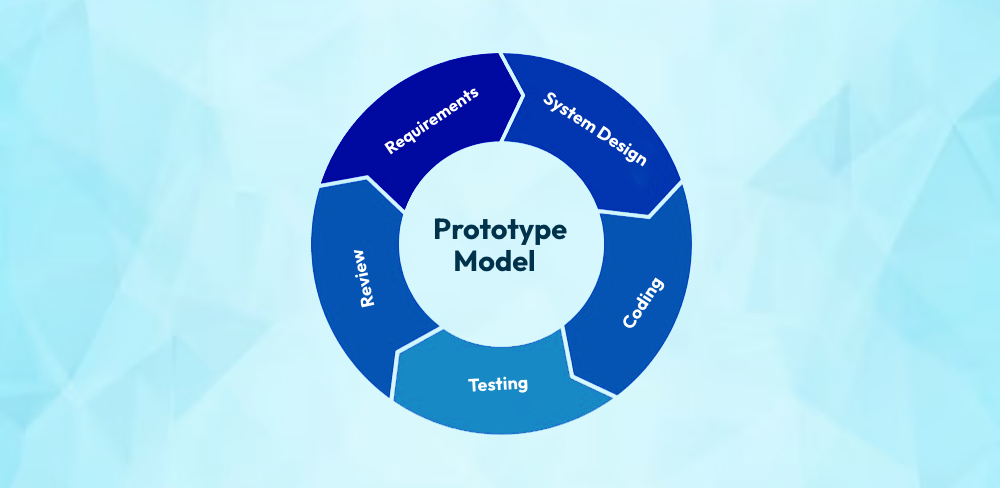
Suitability: A prototype model is appropriate when there is no set deadline, the end user demand is unclear, and the project is modest enough for two or more developers to collaborate on.
| Pros Of Prototype Model | Cons of Prototype Model |
| Flexible in design | It is a bit expensive |
| Easy to detect errors | Increase intricacy of project |
3. Spiral Model
The procedure of the spiral model is axially curling rather than sequential, and it can be thought of as a risk-driven paradigm. It is the ideal part of both waterfall and modeling methods and adds risk assessment to it. Like Iterative, and Agile, this software development life cycle method is based on testing and evaluating risk in small steps.
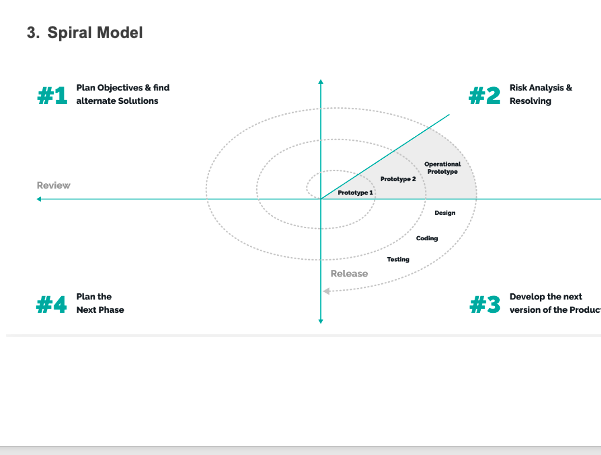
Suitability: That means it works well for big, expensive, and tricky projects. If you don’t know when your project will be finished or what its requirements are, the spiral model is a good way to start making software.
| Pros Of Spiral Model | Cons of Spiral Model |
| Highly flexible model | Can be costly to implement |
| Works well for complex project | Not ideal for small project |
4. V Model
The V-Shaped software development life cycle is also a way where processes are carried out in a certain order, just like the waterfall model. Every step has to be finished before moving on to the next one. The software will be tested at the same time that a similar step of outsource software development in the V-model is planned.
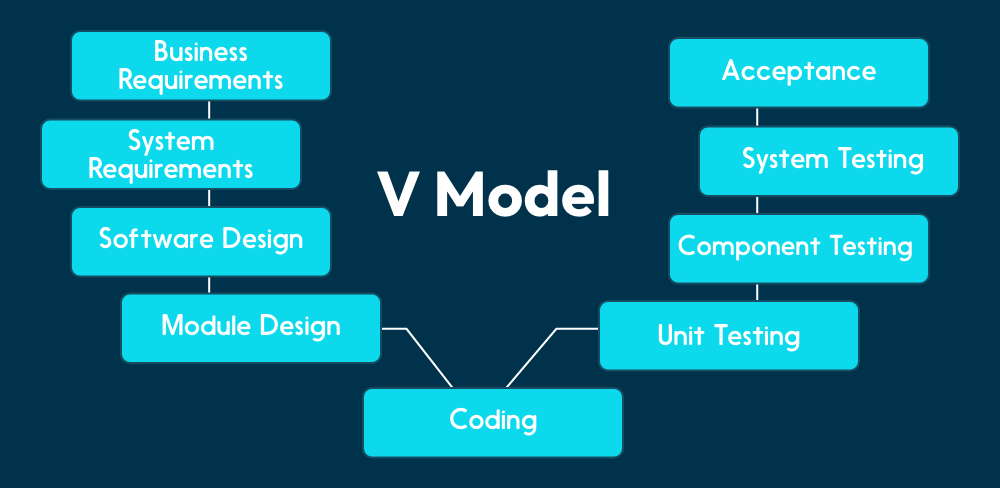
Suitability: This model works best when you have a well-defined project requirement and a well-thought-out plan. When the project and the end-user needs are fixed, it works well for medium-sized software development life cycle projects.
| Pros Of V Model | Cons of V Model |
| Simple and easy to use | Rigid and least flexible |
| Proactive defect tracking | No early prototypes |
5. Big Bang Model
The Big Bang model lacks a formal structure and begins development without explicit requirements or a predetermined procedure. It works well for many small jobs or research-based tasks.
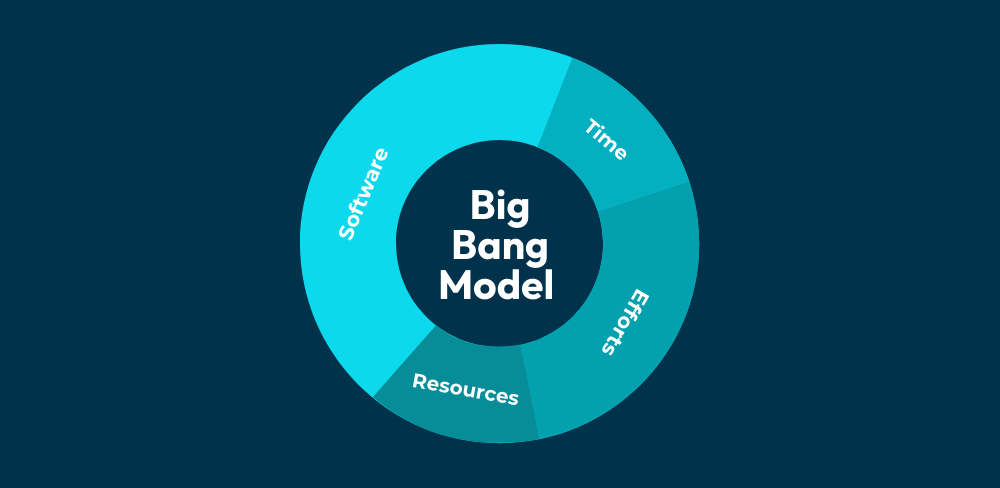
Suitability: This method works well for small jobs that you can start working on right away.
| Pros Of Big Bang Model | Cons of Big Bang Model |
| Easy to implement | Not ideal for complex project |
| Requires less planning | Very high risk |
6. Agile Model
Developing software with an agile software development life cycle has become a growing trend. There are numerous methods to do it other than the usual linear method. Tasks are broken up into short “sprints” that may take 1-4 weeks to finish.
It’s an iterative model, which means that as the work goes on, more tests are done. The custom software development solutions are always asking customers for feedback and making changes to the software based on what they hear.
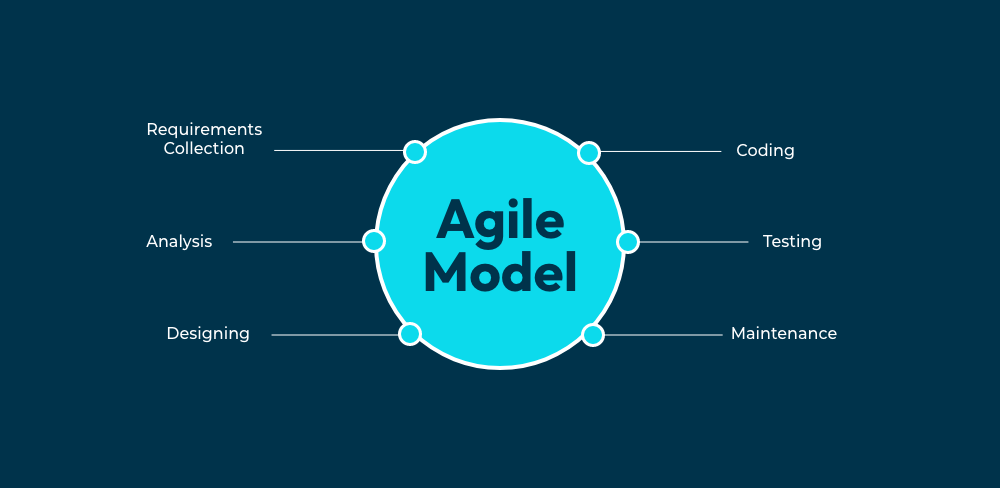
Suitability: Agile is the best model to use when you need to quickly get a software project out on the market, add fresh functions, or change things during the development process.
| Pros Of Agile Model | Cons of Agile Model |
| Timely delivery | Lack of predictability |
| Adaptability | More time and commitment |
7. Iterative Model
The Iterative development model is the most adaptable of all the models we’ve talked about so far. It is the most secure software development life cycle that involves producing successive iterations of the software and. The iterative software development life cycle gradually improves it in response to user input and corrections.

Suitability: Projects that are big, costly and hard to understand can use it. The spiral model is an excellent method to start making software when your project’s due date and requirements are not set in stone.
| Pros Of Iterative Model | Cons of Iterative Model |
| Best suitable for agile firm | Not suitable project |
| Parallel development |
Tips For Choosing Software Development Life Cycle Model
Before you choose the best software development life cycle model, it is crucial to follow the below tips.
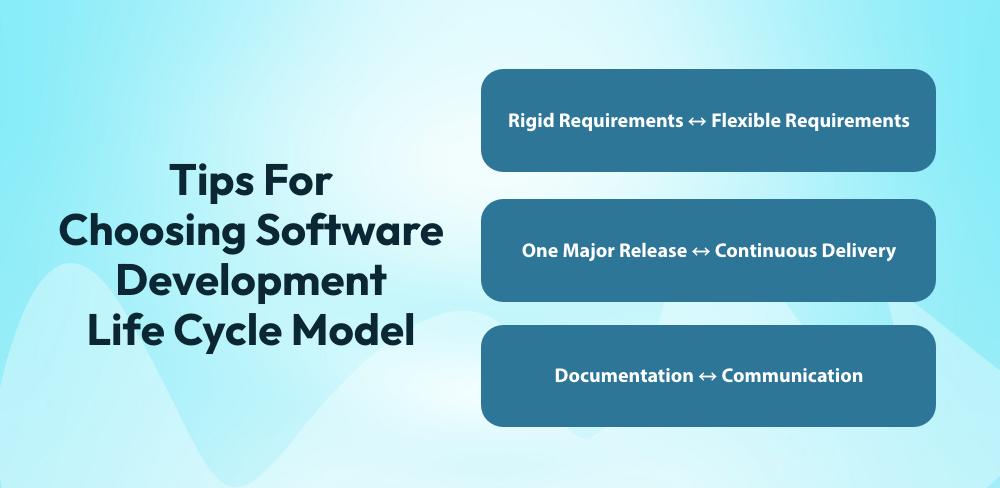
1. Rigid Requirements ↔ Flexible Requirements
Basically, the SDLC model can figure out how flexible software needs to be. Waterfall and V-models start with strict standards and don’t let changes be made. RUP, Iterative, and Scrum are all methods that are rigid but can be changed.
The models that offer the greatest flexibility are Spiral, EX, and Kanban. The Kanban being the most versatile because of its frequent modifications made throughout AI software development.
2. One Major Release ↔ Continuous Delivery
Figure out how your software will grow. Would you like to start a project and see finished software after the first release? You can pick the V-model or the waterfall model. Don’t forget that these two methods work best for little jobs.
Because there is more code for developers and testers to track software, a single final version may have more bugs. To develop software that has new features, all of the stages in the software development life cycle are used for software development life cycle management.
3. Documentation ↔ Communication
It is also essential that you participate in the project and work with SAAS application development services providers. Spiral, V-model, and Waterfall models say that there should be a lot of software development life cycle documentation and not much contact.
Some essential aspects of Agile methods are clear and regular contact. There are many good things about open talks for the Agile group, but you should pick a spokesperson ahead of time. You may not utilize all Agile model meetings for your business.
How Much Does Software Development Cost?
The software development cost for small or medium software can generally lie between $10,000-$30,000. It can vary on the basis of multiple factors like project complexity, technologies used, developers locations and hiring model utilized for hiring custom software developers.
Apart from this, software maintenance and update may also influence the cost to develop software. Let’s now have a look at the cost breakdown in table:
| Type Of Software | Cost Estimation |
| Basic Software | $10000-$15000 |
| Moderate Software | $15000-$22000 |
| Complex Software | $30000+ |
These are just the approximate figures of software development. You can calculate the actual software development life cycles cost by the following formula:
Total Software Development Cost = Developer’s Hour Rate * Development Time
Now that you are well-versed with the average cost and formula of software development, it is time to consult with the top software development companies in USA.
What Is the Maintenance Cost Of Software?
Now that you know the software development cost, it is time to be well-versed in the software maintenance cost. Basically, the cost to maintain a software will be approx. 15-20% of the initial software development cost. Annually you will be charged around $1000-$5000 on its maintenance.
However, its actual cost depends on the factors like bug-fixes, configuration management, documentation, security and so on. Let’s get a brief overview of maintenance cost of a saas software development with table:
| App Maintenance Type | Cost(approx.) |
| Hosting Charges | $70 to $250 Per Month |
| Bug Fixing and Updates | $1000 to $2000 |
| Functional Services | $2000 Per Year |
| IT Support | $1000-$5000 per year |
Ready To Launch An Effective Software Development Project!
Developing an bespoke software that satisfies user needs relies on a software development life cycle that runs smoothly. No matter what approach is used, the software development process must always focus on meeting the needs of the users and solving their main problems.
During the development process at Dev Technosys, we try to keep every stage as useful and focused on the goals of the business as possible. We’ve been making software for newbie startups for 12+ years.
We have the ability to take your idea from being just an idea to meeting all of its requirements. So, if you are ready to launch your own software with the latest technologies, hire dedicated developers from us and take your startups to the next level.
Frequently Asked Questions!
1. How Much Does SaaS Software Development Cost?
The SaaS software development cost can vary depending on your software project requirements. Typically, it can cost between $10000-$30000 or more. It is vital to take help from a software development company for the actual cost.
2. What Are the Benefits Of SDLC?
The benefits of software development life cycle are it gives you a full picture of the whole job. It will have rough estimates of the time, money, and tools that will be needed, which makes planning easier. With SDLC, it’s easy to keep track of even the most complicated projects.
3. How To Select an SDLC Model For a Project?
Picking the best SDLC model for a project is a huge choice. Before you make software decision, you need to know the project’s scope, its schedule, its budget, its resources, and other things.
4. What Are the Software Development Life Cycle Models?
Below are the popular SDLC methodologies:
- Waterfall Model
- Agile Model
- Spiral Model
- Iterative Incremental Model
- Prototype Model
- Big Bang Model
- V-Shaped Model

